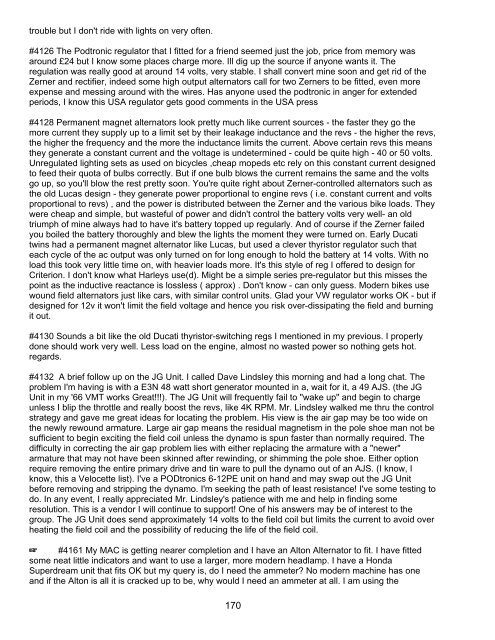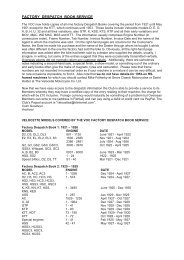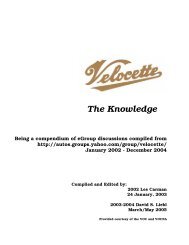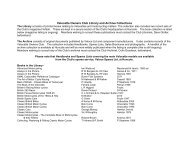The Knowledge - Velocette Owners Club
The Knowledge - Velocette Owners Club
The Knowledge - Velocette Owners Club
You also want an ePaper? Increase the reach of your titles
YUMPU automatically turns print PDFs into web optimized ePapers that Google loves.
trouble but I don't ride with lights on very often.<br />
#4126 <strong>The</strong> Podtronic regulator that I fitted for a friend seemed just the job, price from memory was<br />
around £24 but I know some places charge more. Ill dig up the source if anyone wants it. <strong>The</strong><br />
regulation was really good at around 14 volts, very stable. I shall convert mine soon and get rid of the<br />
Zerner and rectifier, indeed some high output alternators call for two Zerners to be fitted, even more<br />
expense and messing around with the wires. Has anyone used the podtronic in anger for extended<br />
periods, I know this USA regulator gets good comments in the USA press<br />
#4128 Permanent magnet alternators look pretty much like current sources - the faster they go the<br />
more current they supply up to a limit set by their leakage inductance and the revs - the higher the revs,<br />
the higher the frequency and the more the inductance limits the current. Above certain revs this means<br />
they generate a constant current and the voltage is undetermined - could be quite high - 40 or 50 volts.<br />
Unregulated lighting sets as used on bicycles ,cheap mopeds etc rely on this constant current designed<br />
to feed their quota of bulbs correctly. But if one bulb blows the current remains the same and the volts<br />
go up, so you'll blow the rest pretty soon. You're quite right about Zerner-controlled alternators such as<br />
the old Lucas design - they generate power proportional to engine revs ( i.e. constant current and volts<br />
proportional to revs) , and the power is distributed between the Zerner and the various bike loads. <strong>The</strong>y<br />
were cheap and simple, but wasteful of power and didn't control the battery volts very well- an old<br />
triumph of mine always had to have it's battery topped up regularly. And of course if the Zerner failed<br />
you boiled the battery thoroughly and blew the lights the moment they were turned on. Early Ducati<br />
twins had a permanent magnet alternator like Lucas, but used a clever thyristor regulator such that<br />
each cycle of the ac output was only turned on for long enough to hold the battery at 14 volts. With no<br />
load this took very little time on, with heavier loads more. It's this style of reg I offered to design for<br />
Criterion. I don't know what Harleys use(d). Might be a simple series pre-regulator but this misses the<br />
point as the inductive reactance is lossless ( approx) . Don't know - can only guess. Modern bikes use<br />
wound field alternators just like cars, with similar control units. Glad your VW regulator works OK - but if<br />
designed for 12v it won't limit the field voltage and hence you risk over-dissipating the field and burning<br />
it out.<br />
#4130 Sounds a bit like the old Ducati thyristor-switching regs I mentioned in my previous. I properly<br />
done should work very well. Less load on the engine, almost no wasted power so nothing gets hot.<br />
regards.<br />
#4132 A brief follow up on the JG Unit. I called Dave Lindsley this morning and had a long chat. <strong>The</strong><br />
problem I'm having is with a E3N 48 watt short generator mounted in a, wait for it, a 49 AJS. (the JG<br />
Unit in my '66 VMT works Great!!!). <strong>The</strong> JG Unit will frequently fail to "wake up" and begin to charge<br />
unless I blip the throttle and really boost the revs, like 4K RPM. Mr. Lindsley walked me thru the control<br />
strategy and gave me great ideas for locating the problem. His view is the air gap may be too wide on<br />
the newly rewound armature. Large air gap means the residual magnetism in the pole shoe man not be<br />
sufficient to begin exciting the field coil unless the dynamo is spun faster than normally required. <strong>The</strong><br />
difficulty in correcting the air gap problem lies with either replacing the armature with a "newer"<br />
armature that may not have been skinned after rewinding, or shimming the pole shoe. Either option<br />
require removing the entire primary drive and tin ware to pull the dynamo out of an AJS. (I know, I<br />
know, this a <strong>Velocette</strong> list). I've a PODtronics 6-12PE unit on hand and may swap out the JG Unit<br />
before removing and stripping the dynamo. I'm seeking the path of least resistance! I've some testing to<br />
do. In any event, I really appreciated Mr. Lindsley's patience with me and help in finding some<br />
resolution. This is a vendor I will continue to support! One of his answers may be of interest to the<br />
group. <strong>The</strong> JG Unit does send approximately 14 volts to the field coil but limits the current to avoid over<br />
heating the field coil and the possibility of reducing the life of the field coil.<br />
L #4161 My MAC is getting nearer completion and I have an Alton Alternator to fit. I have fitted<br />
some neat little indicators and want to use a larger, more modern headlamp. I have a Honda<br />
Superdream unit that fits OK but my query is, do I need the ammeter? No modern machine has one<br />
and if the Alton is all it is cracked up to be, why would I need an ammeter at all. I am using the<br />
170





